Agile Product Backlog
What is a Product Backlog?
The Product Backlog is essentially a to-do list for the development team. It contains all the features, enhancements, bug fixes, and other tasks needed to improve the product. Think of it as a dynamic list that evolves as the product grows and customer needs change. This list is maintained and prioritized by the Product Owner.

Who Owns the Product Backlog?
The Product Owner is responsible for the Product Backlog. They ensure that the backlog is up-to-date, prioritized, and clearly communicates the tasks to the development team. The Product Owner collaborates with stakeholders to gather requirements and feedback. This role is crucial in aligning the team's work with business goals.
What Does the Product Backlog Contain?
The Product Backlog includes various items such as:
- User Stories: Descriptions of features from the user's perspective.
- Bug Fixes: Issues that need to be resolved to improve product functionality.
- Technical Work: Tasks related to infrastructure or technical improvements.
- Research: Exploratory tasks to gain knowledge or reduce uncertainty.
Each item is detailed enough for the development team to understand and work on.
How is the Product Backlog Managed?
Managing the Product Backlog involves regular updates and prioritization. The Product Owner reviews and adjusts the backlog based on stakeholder feedback and changing requirements. High-priority items are moved to the top, ensuring the team works on the most valuable tasks first. This ongoing process is known as backlog refinement or grooming.
Prioritizing the Product Backlog
Prioritization is key to delivering value efficiently. The Product Owner ranks items based on factors like business value, urgency, and dependencies. Techniques such as MoSCoW (Must have, Should have, Could have, Won't have) can aid in this process. Regular prioritization ensures the team focuses on what's most important.
Refinement of the Product Backlog
Backlog refinement is a collaborative process where the team reviews and updates the backlog. This includes clarifying item details, estimating effort, and breaking down large tasks. Regular refinement sessions help maintain a healthy backlog and prepare for upcoming sprints. It's recommended to allocate about 10% of the team's capacity for this activity.
Difference Between Product Backlog and Sprint Backlog
While the Product Backlog is a comprehensive list of all desired work, the Sprint Backlog is a subset selected for a specific sprint. During sprint planning, the team chooses items from the Product Backlog to work on in the upcoming sprint. The Sprint Backlog is more detailed, outlining the tasks needed to complete each item. This distinction helps in organizing and managing work effectively.
